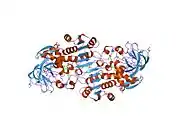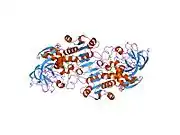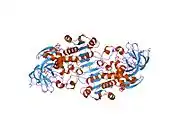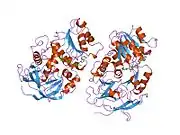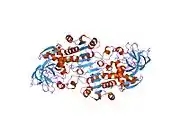| ADH5 | |||||||||||||||||||||||||||||||||||||||||||||||||||
|---|---|---|---|---|---|---|---|---|---|---|---|---|---|---|---|---|---|---|---|---|---|---|---|---|---|---|---|---|---|---|---|---|---|---|---|---|---|---|---|---|---|---|---|---|---|---|---|---|---|---|---|
 | |||||||||||||||||||||||||||||||||||||||||||||||||||
| |||||||||||||||||||||||||||||||||||||||||||||||||||
| Identifiers | |||||||||||||||||||||||||||||||||||||||||||||||||||
| Aliases | ADH5, ADH-3, ADHX, FALDH, FDH, GSH-FDH, GSNOR, HEL-S-60p, alcohol dehydrogenase 5 (class III), chi polypeptide, BMFS7, AMEDS | ||||||||||||||||||||||||||||||||||||||||||||||||||
| External IDs | OMIM: 103710 MGI: 87929 HomoloGene: 68076 GeneCards: ADH5 | ||||||||||||||||||||||||||||||||||||||||||||||||||
| |||||||||||||||||||||||||||||||||||||||||||||||||||
| |||||||||||||||||||||||||||||||||||||||||||||||||||
| |||||||||||||||||||||||||||||||||||||||||||||||||||
| |||||||||||||||||||||||||||||||||||||||||||||||||||
| Wikidata | |||||||||||||||||||||||||||||||||||||||||||||||||||
| |||||||||||||||||||||||||||||||||||||||||||||||||||
Alcohol dehydrogenase class-3 is an enzyme that in humans is encoded by the ADH5 gene.[5][6][7]
This gene encodes glutathione-dependent formaldehyde dehydrogenase or the class III alcohol dehydrogenase chi subunit, which is a member of the alcohol dehydrogenase family. Members of this family metabolize a wide variety of substrates, including ethanol, retinol, other aliphatic alcohols, hydroxysteroids, and lipid peroxidation products. Class III alcohol dehydrogenase is a homodimer composed of 2 chi subunits. It has virtually no activity for ethanol oxidation, but exhibits high activity for oxidation of long-chain primary alcohols and for oxidation of S-hydroxymethyl-glutathione, a spontaneous adduct between formaldehyde and glutathione.
This enzyme is an important component of cellular metabolism for the elimination of formaldehyde, a potent irritant and sensitizing agent that causes lacrymation, rhinitis, pharyngitis, and contact dermatitis.[7]
Clinical significance
Mutations of the ADH5 gene cause AMED syndrome, an autosomal recessive digenic multisystem disorder characterized by global developmental delay with impaired intellectual development. The syndrome was first described in 2020.
References
- 1 2 3 GRCh38: Ensembl release 89: ENSG00000197894 - Ensembl, May 2017
- 1 2 3 GRCm38: Ensembl release 89: ENSMUSG00000028138 - Ensembl, May 2017
- ↑ "Human PubMed Reference:". National Center for Biotechnology Information, U.S. National Library of Medicine.
- ↑ "Mouse PubMed Reference:". National Center for Biotechnology Information, U.S. National Library of Medicine.
- ↑ Hur MW, Edenberg HJ (Dec 1992). "Cloning and characterization of the ADH5 gene encoding human alcohol dehydrogenase 5, formaldehyde dehydrogenase". Gene. 121 (2): 305–11. doi:10.1016/0378-1119(92)90135-C. PMID 1446828.
- ↑ Adinolfi A, Adinolfi M, Hopkinson DA (May 1984). "Immunological and biochemical characterization of the human alcohol dehydrogenase chi-ADH isozyme". Ann Hum Genet. 48 (Pt 1): 1–10. doi:10.1111/j.1469-1809.1984.tb00828.x. PMID 6424546. S2CID 85113864.
- 1 2 "Entrez Gene: ADH5 alcohol dehydrogenase 5 (class III), chi polypeptide".
Further reading
- Iborra FJ, Renau-Piqueras J, Portoles M, et al. (1992). "Immunocytochemical and biochemical demonstration of formaldhyde dehydrogenase (class III alcohol dehydrogenase) in the nucleus". J. Histochem. Cytochem. 40 (12): 1865–78. doi:10.1177/40.12.1453005. PMID 1453005.
- Giri PR, Krug JF, Kozak C, et al. (1989). "Cloning and comparative mapping of a human class III (chi) alcohol dehydrogenase cDNA". Biochem. Biophys. Res. Commun. 164 (1): 453–60. doi:10.1016/0006-291X(89)91741-5. PMID 2679557.
- Sharma CP, Fox EA, Holmquist B, et al. (1989). "cDNA sequence of human class III alcohol dehydrogenase". Biochem. Biophys. Res. Commun. 164 (2): 631–7. doi:10.1016/0006-291X(89)91507-6. PMID 2818582.
- Beisswenger TB, Holmquist B, Vallee BL (1986). "chi-ADH is the sole alcohol dehydrogenase isozyme of mammalian brains: implications and inferences". Proc. Natl. Acad. Sci. U.S.A. 82 (24): 8369–73. doi:10.1073/pnas.82.24.8369. PMC 390917. PMID 2934732.
- Dafeldecker WP, Vallee BL (1986). "Organ-specific human alcohol dehydrogenase: isolation and characterization of isozymes from testis". Biochem. Biophys. Res. Commun. 134 (3): 1056–63. doi:10.1016/0006-291X(86)90358-X. PMID 2936344.
- Kaiser R, Holmquist B, Hempel J, et al. (1988). "Class III human liver alcohol dehydrogenase: a novel structural type equidistantly related to the class I and class II enzymes". Biochemistry. 27 (4): 1132–40. doi:10.1021/bi00404a009. PMID 3365377.
- Khokha AM, Voronov PP, Zimatkin SM (1994). "[Immunoenzyme and immunohistochemical analysis of class III alcohol dehydrogenase from human testis]". Biokhimiia. 59 (7): 997–1002. PMID 7948423.
- Engeland K, Höög JO, Holmquist B, et al. (1993). "Mutation of Arg-115 of human class III alcohol dehydrogenase: a binding site required for formaldehyde dehydrogenase activity and fatty acid activation". Proc. Natl. Acad. Sci. U.S.A. 90 (6): 2491–4. doi:10.1073/pnas.90.6.2491. PMC 46113. PMID 8460164.
- Holmquist B, Moulis JM, Engeland K, Vallee BL (1993). "Role of arginine 115 in fatty acid activation and formaldehyde dehydrogenase activity of human class III alcohol dehydrogenase". Biochemistry. 32 (19): 5139–44. doi:10.1021/bi00070a024. PMID 8494891.
- Engeland K, Maret W (1993). "Extrahepatic, differential expression of four classes of human alcohol dehydrogenase". Biochem. Biophys. Res. Commun. 193 (1): 47–53. doi:10.1006/bbrc.1993.1588. PMID 8503936.
- Yang ZN, Bosron WF, Hurley TD (1997). "Structure of human chi chi alcohol dehydrogenase: a glutathione-dependent formaldehyde dehydrogenase". J. Mol. Biol. 265 (3): 330–43. doi:10.1006/jmbi.1996.0731. PMID 9018047.
- Mori O, Haseba T, Kameyama K, et al. (2000). "Histological distribution of class III alcohol dehydrogenase in human brain". Brain Res. 852 (1): 186–90. doi:10.1016/S0006-8993(99)02201-5. PMID 10661511. S2CID 23510523.
- Sanghani PC, Stone CL, Ray BD, et al. (2000). "Kinetic mechanism of human glutathione-dependent formaldehyde dehydrogenase". Biochemistry. 39 (35): 10720–9. doi:10.1021/bi9929711. PMID 10978156.
- Lee DK, Suh D, Edenberg HJ, Hur MW (2002). "POZ domain transcription factor, FBI-1, represses transcription of ADH5/FDH by interacting with the zinc finger and interfering with DNA binding activity of Sp1". J. Biol. Chem. 277 (30): 26761–8. doi:10.1074/jbc.M202078200. PMID 12004059.
- Jelski W, Chrostek L, Szmitkowski M, Laszewicz W (2002). "Activity of class I, II, III, and IV alcohol dehydrogenase isoenzymes in human gastric mucosa". Dig. Dis. Sci. 47 (7): 1554–7. doi:10.1023/A:1015871219922. PMID 12141816. S2CID 31197228.
- Sanghani PC, Robinson H, Bosron WF, Hurley TD (2002). "Human glutathione-dependent formaldehyde dehydrogenase. Structures of apo, binary, and inhibitory ternary complexes". Biochemistry. 41 (35): 10778–86. doi:10.1021/bi0257639. PMID 12196016.
- Strausberg RL, Feingold EA, Grouse LH, et al. (2003). "Generation and initial analysis of more than 15,000 full-length human and mouse cDNA sequences". Proc. Natl. Acad. Sci. U.S.A. 99 (26): 16899–903. Bibcode:2002PNAS...9916899M. doi:10.1073/pnas.242603899. PMC 139241. PMID 12477932.
- Sanghani PC, Bosron WF, Hurley TD (2003). "Human glutathione-dependent formaldehyde dehydrogenase. Structural changes associated with ternary complex formation". Biochemistry. 41 (51): 15189–94. doi:10.1021/bi026705q. PMID 12484756.
External links
- Human ADH5 genome location and ADH5 gene details page in the UCSC Genome Browser.





